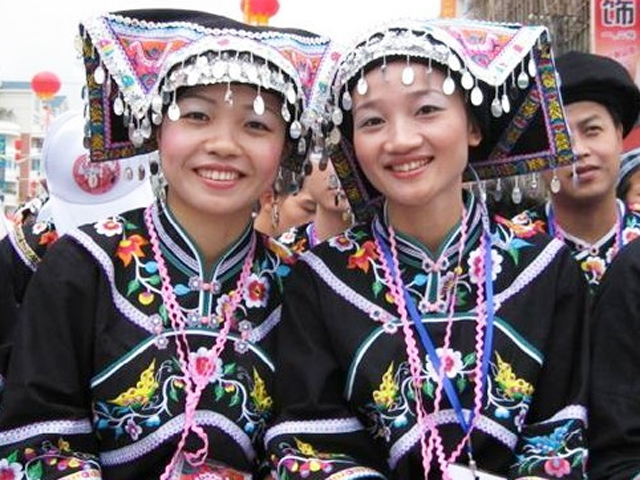 Guizhou Tour Guide
Guizhou Tour Guide Guizhou Hotels
Guizhou HotelsQuick Enquiry
Guizhou Ethnic Minorities
Spread out among the beautiful countryside lives a lively mix of people. Almost 35% of Guizhou's population is made up of over 13 national ethnic minorities, including Miao, Dong, Buyi, Yi, Tujia, etc., all with their own long-established and brilliant cultures. Thus Guizhou is superb for its colorful and distinctive ethnic customs and cultures. Three Autonomous Prefectures, homing major minorities in Guizhou, are Qiandongnan Miao-Dong Autonomous Prefecture, Qiannan Buoyei-Miao Autonomous Prefecture and Qianxinan Buoyei-Miao Autonomous Prefecture. ChinaTourGuide will take you to recognize the differences among three main minority groups - Miao, Dong and Buoyei.
Miao People / Miao Minority / Miao Tribes
With a population of more than seven million, the Miao people form one of the largest ethnic minorities in southwest China. The Miao language belongs to the Miao-Yao branch of the Chinese-Tibetan language family. The Miao are very famous for their silverware, and come festival time you'll see the younger girls literally weighed down by their giant, elaborate headdresses and row upon row of necklaces and bangles. The Miao have a highly diversified culture developed from a common root. They are fond of singing and dancing, and have a highly-developed folk literature. And Miao people always seem to have someting to celebrate, so make sure you come in a festival time. Check Miao's festival calendar to plan your trip to Guizhou.
Dong People / Dong Minority / Dong Tribes
 The population of Dong ethnic group in China is 2.5 million. The Dong are respected architects and their houses, built of fir wood, are usually two or three stories high. Those located on steep slopes or riverbanks stand on stilts; people live on the upper floors, and the ground floor is reserved for domestic animals and firewood. Men usually wear short jackets with front buttons. In the mountainous localities in the south, they wear collarless skirts and turbans. The females are dressed in skirts or trousers with beautifully embroidered hems. Women wrap their legs and heads in scarves, and wear their hair in a coil. The Dongs also have many festivals -- Spring Festival, Worshipping Ox Festival, New Harvest Festival, Pure Brightness Festival and Dragon Boat Festival.
The population of Dong ethnic group in China is 2.5 million. The Dong are respected architects and their houses, built of fir wood, are usually two or three stories high. Those located on steep slopes or riverbanks stand on stilts; people live on the upper floors, and the ground floor is reserved for domestic animals and firewood. Men usually wear short jackets with front buttons. In the mountainous localities in the south, they wear collarless skirts and turbans. The females are dressed in skirts or trousers with beautifully embroidered hems. Women wrap their legs and heads in scarves, and wear their hair in a coil. The Dongs also have many festivals -- Spring Festival, Worshipping Ox Festival, New Harvest Festival, Pure Brightness Festival and Dragon Boat Festival.
Buyi Buoyei Buoyi People / Buyi Minority / Buoyei Tribes
 Most of China's 2,548,300 Bouyei people live in several Bouyei-Miao autonomous counties in Xingyi and Anshun prefectures and Qiannan Bouyei-Miao Autonomous Prefecture in Guizhou Province. They live mostly on plains or in river valleys in villages composed of families from several different clans, in two-storied houses, bungalows or a combination of the two. Often people live on an upper floor, and keep livestock on the lower. Young Bouyei males generally wear short buttoned jackets and long trousers, with scarves on their heads. Women wear jackets buttoned on the right (although some young women prefer lace-trimmed jackets buttoning down the middle), and long trousers or pleated skirts. They also wear scarves and a variety of silver jewelry. This ethnic group possesses a rich folk literature, which includes fairy tales, fables, folk songs, proverbs and poems.
Most of China's 2,548,300 Bouyei people live in several Bouyei-Miao autonomous counties in Xingyi and Anshun prefectures and Qiannan Bouyei-Miao Autonomous Prefecture in Guizhou Province. They live mostly on plains or in river valleys in villages composed of families from several different clans, in two-storied houses, bungalows or a combination of the two. Often people live on an upper floor, and keep livestock on the lower. Young Bouyei males generally wear short buttoned jackets and long trousers, with scarves on their heads. Women wear jackets buttoned on the right (although some young women prefer lace-trimmed jackets buttoning down the middle), and long trousers or pleated skirts. They also wear scarves and a variety of silver jewelry. This ethnic group possesses a rich folk literature, which includes fairy tales, fables, folk songs, proverbs and poems.
Festival Highlights of Guizhou Minorities

- Sisters' Meal Festival
- --Known as the oldest oriental Valentine's Day

- Lusheng Festival
- --Most influential festival of the Miao community
- Miao's New Year
- --Most important festival for the Miao people

- Bullfight Festival
- --Bullfight is an important part in Miao's culture
Recommended Guizhou Festival Tours
Recommended China Tours with Guizhou
- HRC-GY09 : 10 Days Guizhou Miao Dong Village Tour with Guilin Extension from $1389
(Guiyang - Kaili - Zhaoxing - Sanjiang - Longsheng - Guilin )
- HRC-TMR01: 16 days Amazing Minority & Majestic Scenery Tour from $1568
(Kunming - Dali - Lijiang - Zhongdian - Kunming - Guiyang - Kaili - Zhaoxing - Sanjiang - Longsheng - Guilin - Yangshuo)
Guide for China tour, offers most value & amazing experience. In China, you can rely on us
Copyright © 2001 - 2025. All Rights Reserved to ChinaTourGuide.Com
Hotel Guangzhou | Guizhou Tours | Hong Kong Hotels | 香港酒店 | 广州酒店 | 广州会议酒店 | Indochina Tour
Guide for China tours, offers most value & amazing experience. Chinatourguide.com. Your reliable China tour agency.



